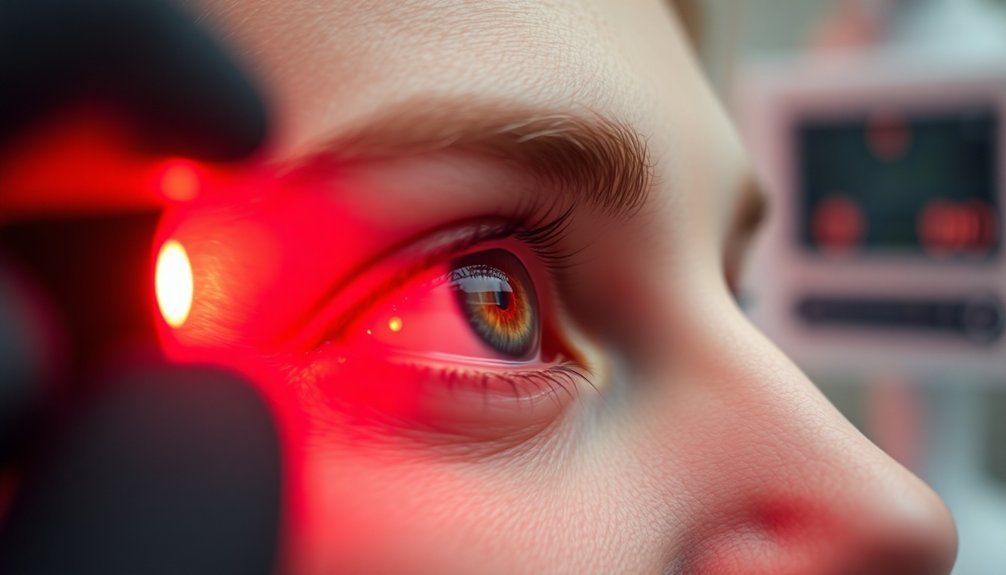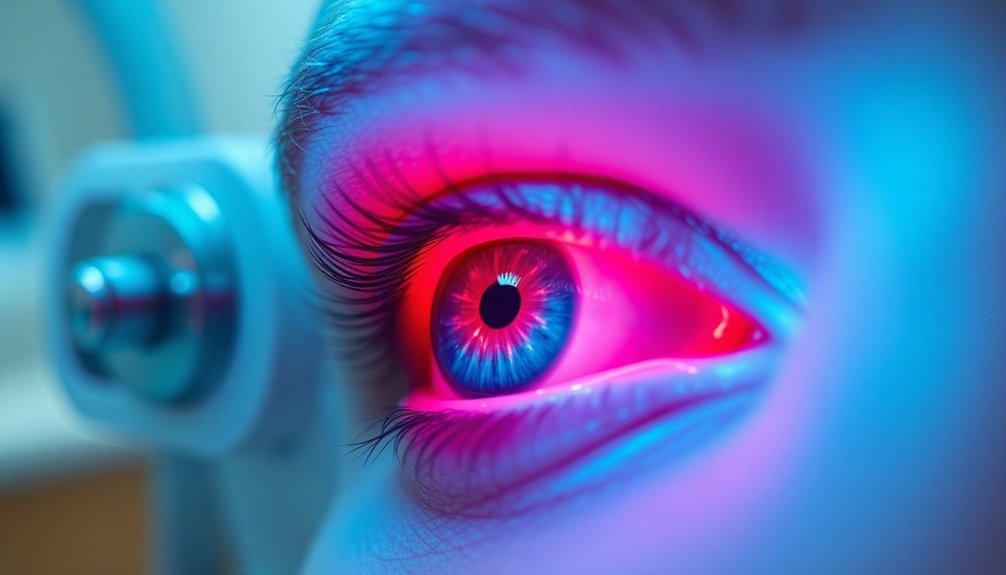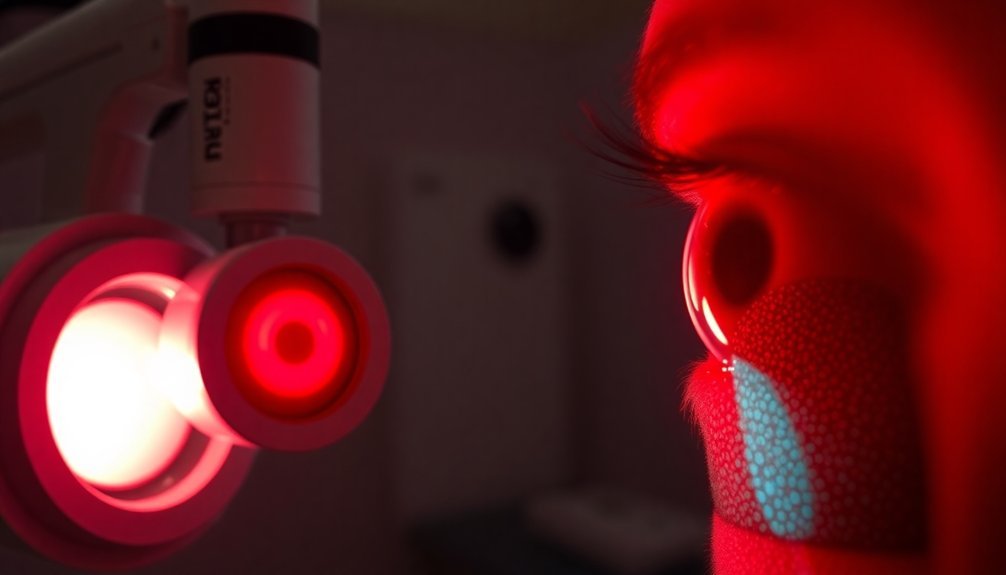Photobiomodulation effectively treats nearsightedness by using specific wavelengths of light to trigger positive changes in your eye cells. This non-invasive therapy works by stimulating your mitochondria – the powerhouses of your cells – to produce more energy (ATP) and activate protective pathways in your retinal cells. You'll typically receive two 3-minute daily treatments that help slow axial eye growth and reduce myopia progression. Clinical trials have shown significant improvements in visual acuity with minimal side effects, making it a promising alternative to traditional treatments. The science behind this revolutionary approach reveals an exciting frontier in vision care.
Understanding Photobiomodulation Light Therapy

Through recent advances in ophthalmology, photobiomodulation (PBM) light therapy has emerged as a promising treatment for nearsightedness.
PBM uses specific red light wavelengths, typically at 650 nm, to induce hyperopia and help control myopia progression. The treatment involves low-power laser or LED applications that promote tissue repair while reducing inflammation.
When you undergo PBM therapy, you'll need to follow a precise treatment schedule of two 3-minute sessions daily, separated by at least 4 hours. The light intensity is carefully controlled at 2 ± 0.5 mW to guarantee effectiveness without causing damage to your retina. Clinical data demonstrates a 55% reduction in axial length after just one month of treatment.
Studies have shown that PBM outperforms traditional treatments like orthokeratology lenses, particularly in the first year of treatment.
You should be aware that while PBM is generally safe, you might experience temporary side effects like flash blindness or afterimages. These effects are immediate but reversible. The good news is that no severe systemic or ocular disease-related adverse effects have been reported.
However, it's important to note that high-intensity light exposure can cause irreversible damage, which is why proper administration and adherence to recommended parameters are vital.
Cellular Changes During Light Treatment
A cascade of cellular changes unfolds when photobiomodulation light interacts with your retinal cells. The process begins when your mitochondria absorb light energy, converting it into ATP – your cells' primary energy source.
This triggers a series of beneficial reactions, including the creation of mild oxidants and increased nitric oxide availability, which activate essential gene transcription factors. The AKT and ERK pathways are activated during this process, providing additional neuroprotective effects.
Your cells respond to photobiomodulation through several key mechanisms, particularly through the activation of cytochrome c oxidase, which enhances electron transport in your mitochondria. This leads to improved cellular function and therapeutic outcomes through:
- Increased metabolic activity and ATP production, giving your retinal cells more energy to function at their best
- Reduced inflammation and oxidative stress, protecting your eye tissues from damage
- Enhanced cell survival and structural repair, particularly beneficial for photoreceptors
These cellular changes culminate in protective effects against retinal degeneration and improved visual function. The non-thermal nature of photobiomodulation guarantees these benefits occur without damaging your eye tissues, making it an effective treatment option for promoting cellular repair and the optimization of retinal function.
Clinical Evidence For Myopia Control

Clinical trials show that red-light therapy and photobiomodulation treatments can substantially slow your eye's axial elongation and reduce myopia progression compared to traditional single vision spectacles.
You'll find consistent evidence from multiple studies demonstrating that these light-based treatments are both safe and effective, with no reports of severe adverse events over extended treatment periods. A recent European trial using twice daily treatments showed promising results in managing pediatric myopia.
The long-term results are particularly promising, as two-year follow-up studies reveal sustained vision improvements, though you'll need to continue treatments to maintain the benefits and prevent potential rebound effects.
Significant Trial Results Revealed
Recent groundbreaking trials have demonstrated promising results for photobiomodulation in myopia control. The MyopiaX-1 trial, involving 124 children, has shown that this non-invasive light-based treatment is both safe and effective at slowing myopia progression. The trial was conducted across six European countries, including Germany, Spain, the Netherlands, and the United Kingdom.
Through a virtual reality headset, MyopiaX delivers targeted photobiomodulation that stimulates specific cells in your child's eyes to regulate natural signaling pathways.
A comparative study of 50 children revealed significant advantages of photobiomodulation therapy:
- Reduced axial length growth by 0.50 mm compared to controls over 12 months
- Improved cycloplegic spherical equivalent refraction by +1.25 Diopters
- Demonstrated safety with no reported ocular adverse events
You'll find the treatment particularly appealing as it's delivered through an engaging virtual reality platform that children can use at home.
The six-month outcomes from the MyopiaX-1 trial confirm its clinical safety profile, while ongoing studies are set to conclude in September 2024. With regulatory discussions already underway, this innovative therapy could soon offer you a new option for managing your child's myopia progression effectively.
Long-Term Vision Improvements Measured
Long-term studies tracking photobiomodulation therapy have revealed sustained vision improvements in children with myopia. Clinical evidence shows that PBM therapy effectively reduces both axial elongation and spherical equivalence refraction progression when compared to traditional single vision spectacles.
The treatment's effectiveness has been documented over periods ranging from 12 months to 2 years, with twice-daily red-light therapy sessions showing particularly promising results.
PBM therapy works differently than single vision lenses by targeting both central and peripheral vision. The therapy uses specific wavelengths, typically 650 nm, to create a "slow-down" signal for eye growth. During standard treatment, you'll need to undergo 3-minute sessions twice daily to achieve ideal results.
The MyopiaX-1 trial has confirmed these findings, demonstrating significant improvements in children aged 8-13 years. What's particularly encouraging is that 2-year post-trial follow-ups continue to show sustained benefits, though researchers are carefully monitoring for any potential rebound effects after treatment ends.
These long-term studies are vital for understanding how PBM therapy can provide lasting myopia control.
Light Wavelengths And Eye Health
Understanding how light wavelengths affect eye health reveals fascinating patterns in myopia development and treatment. Research shows that different wavelengths can either protect against or promote nearsightedness, with red and infrared light offering promising therapeutic benefits.
You'll find that wavelength specificity plays a vital role in how light affects your eyes. While long wavelengths like red light can protect against myopia in some cases, shorter wavelengths such as blue light may lead to different refractive conditions.
This knowledge has led to targeted photobiomodulation therapies using specific wavelengths between 650-810 nm.
- Deep red light (670 nm) can enhance your retina's mitochondrial performance, improving overall vision quality
- Clinical studies demonstrate that controlled red light exposure helps manage myopia progression
- Your retinal cells respond differently to various wavelengths, affecting both choroidal thickness and axial length
The cellular mechanisms behind these effects are complex, involving your eye's cone cells and mitochondrial responses. Scientists continue to study the best wavelengths for myopia treatment through photobiomodulation, with current research focusing on wavelengths around 650 nm at 2 mW/cm2 intensity.
Understanding these relationships helps develop more effective treatments for nearsightedness.
Treatment Safety And Effectiveness

Research confirms that photobiomodulation offers you a safe, non-invasive treatment option for nearsightedness with minimal risk of adverse effects.
You'll find comfort in knowing that clinical studies demonstrate significant improvements in visual acuity through targeted light therapy that stimulates cellular repair mechanisms.
The treatment's proven ability to enhance mitochondrial function and promote tissue regeneration suggests it can help protect your vision over the long term.
Clinical Evidence Supports Safety
Compelling clinical evidence demonstrates the safety and effectiveness of photobiomodulation (PBM) therapy for treating various ocular conditions, particularly myopia and age-related macular degeneration (AMD). Studies show that PBM effectively reduces axial length growth and spherical equivalent refraction progression in children with myopia, while also improving visual acuity in AMD patients.
PBM therapy has proven remarkably safe, with no severe side effects reported in clinical trials. While you might experience temporary flash blindness or afterimages immediately after treatment, these effects are reversible and not severe.
Key benefits of PBM therapy include:
- Near-infrared light penetrates deeper into ocular tissues compared to shorter wavelengths, enabling effective treatment of various eye conditions
- Treatment is most effective in early disease stages, particularly for conditions like AMD before significant cell loss occurs
- Clinical trials consistently show PBM can help stabilize myopia progression and reduce axial length growth in children
When considering PBM treatment, you should know it's particularly effective in early intervention scenarios, though careful monitoring is needed for specific conditions like subfoveal drusenoid pigment epithelium detachment.
Non-Invasive Treatment Benefits
Through rigorous clinical trials and studies, photobiomodulation has emerged as a safe, non-invasive treatment option for various eye conditions.
PBM uses non-ionizing light sources, including LEDs and lasers, which don't cause thermal damage or harmful side effects to your eyes. The treatment works naturally with your body's cellular processes, stimulating tissue regeneration without any invasive procedures.
When you undergo PBM treatment, you're benefiting from a therapy that's been cleared by the FDA through their Premarket Notification process. The treatment's effectiveness lies in its ability to interact with chromophores in your cells, enhancing mitochondrial function and promoting cellular health.
You won't experience any phototoxicity during or after the treatment, as multiple studies have consistently confirmed its safety profile.
What's particularly advantageous is PBM's biphasic dose response – your healthcare provider can precisely control the light levels to achieve ideal therapeutic effects. This precise control, combined with the treatment's non-invasive nature, makes it an attractive option for managing nearsightedness while avoiding the risks associated with more invasive procedures.
Long-Term Vision Protection
Studies spanning multiple years have demonstrated PBM's impressive track record in protecting long-term vision health.
Clinical trials have shown that PBM effectively reduces myopia progression over 12 months, particularly when using 650 nm wavelength treatments twice daily for 3-minute sessions. You'll find that PBM not only stabilizes myopia but also helps prevent photoreceptor degeneration and protects your retinal pigment epithelium.
The treatment's long-term effectiveness relies on proper dosing and timing. Research shows that specific doses between 9-18 J/cm2 provide the best protection, while higher doses can be ineffective or even harmful. You'll get the best results when you start PBM treatment in the early stages of myopia, before significant cell loss occurs.
Key benefits of PBM for long-term vision protection include:
- Inhibits structural and functional degeneration associated with vision problems
- Reduces photoreceptor cell death when administered at correct dosages
- Demonstrates consistent safety with no severe adverse effects over 12-month periods
While temporary flash blindness may occur, it's completely reversible, making PBM a safe and reliable option for protecting your vision over the long term.
Comparing Traditional Versus Light Therapy
Modern myopia management presents a stark contrast between time-tested traditional approaches and emerging light-based therapies. While traditional methods like spectacles and contact lenses focus primarily on vision correction, they don't address the underlying progression of myopia.
Orthokeratology and atropine therapy offer alternatives, but they come with potential side effects and varying success rates.
Light therapy, particularly photobiomodulation (PBM), takes a different approach by targeting cellular metabolism and retinal health. You'll find that red-light therapy specifically enhances mitochondrial function and has shown compelling evidence for myopia control. The Valeda System, originally developed for dry AMD, demonstrates how light-based treatments can effectively improve vision and slow disease progression.
When you compare the two approaches, light therapy stands out for its promising results and minimal adverse effects. While traditional methods remain essential for immediate vision correction, PBM offers a proactive solution for controlling myopia progression.
However, you should consider the challenges of implementing light therapy, including compliance requirements, standardization needs, and cost factors. These considerations will help you make an informed decision about incorporating light therapy into your myopia management plan.
Long-Term Vision Benefits

Beyond immediate vision correction, photobiomodulation offers substantial long-term benefits for myopia management. The treatment works by enhancing cellular processes, particularly through increased ATP production and improved choroidal blood flow.
You'll find that these biological changes contribute to slowing or even reversing myopia progression while protecting your retinal tissue from oxidative damage.
Clinical evidence supports PBM's lasting effectiveness, demonstrating improved visual acuity and reduced axial elongation over time. What's particularly encouraging is the treatment's favorable safety profile, with minimal side effects reported across various studies.
Through consistent application, you can expect enhanced mitochondrial function and reduced inflammation, which are essential for maintaining long-term eye health.
Key long-term advantages of PBM include:
- Sustained improvement in choroidal blood perfusion, helping to maintain proper eye structure and function
- Protection against retinal cell death and preservation of rod bipolar cells, ensuring better vision stability
- Potential delay in the onset of severe vision loss through continuous management of disease progression
The treatment's effectiveness can be optimized through properly timed sessions and appropriate wavelength selection, ensuring you receive maximum benefit from each treatment cycle.
Future Developments In Light Treatment
Groundbreaking developments in light-based myopia treatments are reshaping the future of vision care. You'll soon see innovative therapies like MyopiaX, which uses virtual reality to deliver targeted photobiomodulation, and advanced red light treatments that strengthen your eye's resilience against axial elongation.
| Treatment Type | Current Development | Future Impact | Clinical Status |
|---|---|---|---|
| MyopiaX | VR-based therapy | Daily home use | 16-month trial ongoing |
| Red Light | 650nm wavelength | School integration | Promising early results |
| Violet Light | Spectacle frames | Supplementary care | Under investigation |
| Bright Light | Natural light levels | Home-based solution | Active research phase |
Clinical trials are rapidly advancing our understanding of these treatments. You'll benefit from the MyopiaX-1 trial, which is evaluating safety and effectiveness in 124 children, while repeated low-level red light therapy shows encouraging results as both primary and supplementary treatment options. As regulatory authorities review these innovations, you can expect more accessible and effective light-based treatments for myopia management. The future looks promising with these emerging technologies that could revolutionize how you manage nearsightedness.
Frequently Asked Questions
How Soon After Starting Treatment Can Patients Expect to See Results?
You'll likely notice initial improvements within 1 month, seeing reduced eye strain, better color contrast, and improved vision. More significant benefits appear at 3 months, with sustained improvements continuing through 6 months.
Can PBM Therapy Be Combined With Contact Lenses or Glasses?
Yes, you can combine PBM therapy with contact lenses, and research is ongoing for glasses integration. Smart contact lenses with built-in light sources are showing promise, though most current treatments use standalone PBM devices.
Is the Treatment Equally Effective for All Age Groups?
You'll find that PBM's effectiveness varies by age. It's most effective in children and young adults for controlling myopia progression, while adults may see more modest results but still benefit from improved visual acuity.
What Happens if Treatment Sessions Are Occasionally Missed?
If you miss occasional sessions, you'll likely experience reduced treatment effectiveness. While there's limited research on exact impacts, consistency is key – regular treatments help maintain benefits and guarantee the best outcomes from photobiomodulation therapy.
Does Weather or Seasonal Change Affect the Treatment's Effectiveness?
No, you don't need to worry about weather or seasons affecting your PBM treatment. The therapy works at a cellular level using specific light wavelengths, so its effectiveness remains consistent regardless of external conditions.
In Summary
You've learned how photobiomodulation uses specific light wavelengths to stimulate cellular repair and reduce myopia progression. While it's still an emerging treatment, the clinical evidence shows promise in slowing nearsightedness when combined with traditional vision care. As research continues, you'll find more advanced light therapy options becoming available. Consider discussing this treatment with your eye care provider to determine if it's right for your vision needs.





Leave a Reply